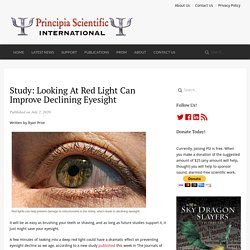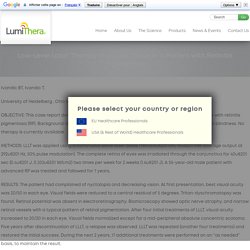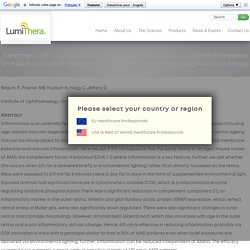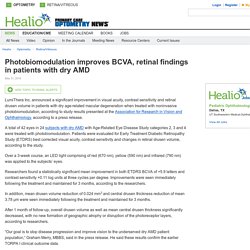

Study: looking at red light can improve declining eyesight. A few minutes of looking into a deep red light could have a dramatic effect on preventing eyesight decline as we age, according to a new study published this week in The Journals of Gerontology.

If the results are replicated in future studies, and approved by the US Food and Drug Administration, the light could augur a new era in which millions of people have access to the easy home-based therapy. It would give them a new layer of protection against the natural aging processes that steal our eyes’ sensitivity to light and ability to distinguish colors. “You don’t need to use it for very long to start getting a strong result,” said lead author Glen Jeffery, a professor of neuroscience at University College London’s Institute of Ophthalmology.
The science works, Jeffery said, because the light stimulates the health of mitochondria, which are like batteries in our cells. All it takes is a few minutes The study was small, a pilot study to test the concept. It’s easy and safe to use. Near-Infrared Light Heals Eyes. Low-Level Laser Therapy Improves Vision in a Patient with Retinitis Pigmentosa. Ivandic BT, Ivandic T.

University of Heidelberg , Otto Meyerhof Centre, Heidelberg, Germany OBJECTIVE: This case report describes the effects of low-level laser therapy (LLLT) in a single patient with retinitis pigmentosa (RP). Background data: RP is a heritable disorder of the retina, which eventually leads to blindness. No therapy is currently available. METHODS: LLLT was applied using a continuous wave laser diode (780uc0u8201 nm, 10u8201 mW average output at 292u8201 Hz, 50% pulse modulation). RESULTS: The patient had complained of nyctalopia and decreasing vision. CONCLUSIONS: LLLT was shown to improve and maintain vision in a patient with RP, and may thereby have contributed to slowing down blindness Photomed Laser Surg. 2014 Mar;32(3):181-4 View on ncbi.nlm.nih.gov.
Treatment with 670 nm Light Upregulates Cytochrome C Oxidase Expression and Reduces Inflammation in an Age-Related Macular Degeneration Model. Begum R, Powner MB, Hudson N, Hogg C, Jeffery G Institute of Ophthalmology, University College London, London, United Kingdom.

Abstract Inflammation is an umbrella feature of ageing. It is present in the aged retina and many retinal diseases including age-related macular degeneration (AMD). In ageing and in AMD mitochondrial function declines. In normal ageing this can be manipulated by brief exposure to 670 nm light on the retina, which increases mitochondrial membrane potential and reduces inflammation. PLoS One 2013 8(2) e57828 View on ncbi.nlm.nih.gov. About LumiThera.
Red Light Saves Sight. Laser therapy improves vision in patients with Age-related Macular Degeneration. Photobiomodulation improves BCVA, retinal findings in patients with dry AMD. LumiThera Inc. announced a significant improvement in visual acuity, contrast sensitivity and retinal drusen volume in patients with dry age-related macular degeneration when treated with noninvasive photobiomodulation, according to study results presented at the Association for Research in Vision and Ophthalmology, according to a press release.

A total of 42 eyes in 24 subjects with dry AMD with Age-Related Eye Disease Study categories 2, 3 and 4 were treated with photobiomodulation. Patients were evaluated for Early Treatment Diabetic Retinopathy Study (ETDRS) best corrected visual acuity, contrast sensitivity and changes in retinal drusen volume, according to the study. Over a 3-week course, an LED light comprising of red (670 nm), yellow (590 nm) and infrared (790 nm) was applied to the subjects’ eyes. Researchers found a statistically significant mean improvement in both ETDRS BCVA of +5.9 letters and contrast sensitivity +0.11 log units at three cycles per degree. Low-Level Laser Therapy Improves Vision in Patients withAge-Related Macular Degeneration. Targeting mitochondrial dysfunction as in aging and glaucoma. Effects of Photobiomodulation Therapy on Patients with Primary Open Angle Glaucoma: A Pilot Study. - PubMed - NCBI. Family squabble over safety of eye therapy forces journal to pull paper.
A father and son are fighting over whether a laser therapy they describe as co-authors of a 2015 paper could be harmful to patients, prompting the journal to retract the article.

The small study suggested that the therapy could safely treat patients with glaucoma. But Tomislav Ivandic — the father — alleges that errors in how the study was reported could lead to harmful doses of laser light for patients receiving the therapy. His son and co-author, Boris Ivandic, maintains that the article is accurate. To err on the side of patient safety, Photomedicine and Laser Surgery retracted “Effects of Photobiomodulation Therapy on Patients with Primary Open Angle Glaucoma: A Pilot Study.”
The retraction note explains the dispute: [This retraction is] due to potentially significant errors in the reported parameters and calculated doses.The second author of the article, Dr. The article has been removed from the journal’s website. Adverse effects were not observed.